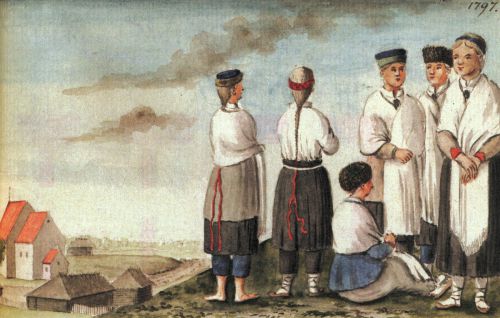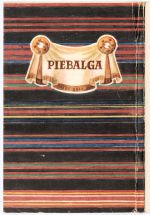The cover's background shows a traditional weave pattern; inside are illustrations datailing:
- vainags — headdress or crown
- brunču raksts — skirt fabric weave pattern
- vņiebura shema — vest schematic
- krekla shema — blouse schematic
- brunču kroku salikums — skirt pleating assembly/arrangement
- cepure — cap/hat
- josta — belt
- saktiņas — smallbrooches
The flip side provides brief overviews in French, English, Russian, and Latvian.
Piebalga
The Piebalga castle district (Prebalge, Latin) is first mentioned in the Tālava partition agreement of 1224. Other mentions throughout history include the archbishop's Piebalga castle (1318), stone/masonry castle (1340), one of Willhelm of Brandenburg's seven manors (1530). The castle was inhabited by the Livonian Duchy's governor of Cēsis, Maciej Dembiński.1 Under the Swedes, the castle was no longer occupied and its lands divided between two manors which came to be named Vecpiebalga ("Old Piebalga") and Jaunpiebalga ("New Piebalga", Neuhof in German). Following the Great Northern War between Sweden and Russia, tsar Peter the Great granted both manors to his general field marshal Boris Sheremetev, to whose heirs the manors belonged until the 1920 agrarian land reform of newly independent Latvia.
Piebalga folk costume
Examining folk costumes in greater detail and their identifying nuances, the folk costumes of Latvia's Vidzeme region can be categorized by northern, eastern, and western Vidzeme, and Piebalga, Lielvārde, and Krustpils districts. The folk costumes of this region incorporate both ancient Liv and Latgalian cultural influences. The eariest preserved folk costumes come from eastern Vidzeme and unfortunately date only to the early 19th century.

As decribed in the caption (full illustration above right), the women gathered together are wearing small, round hats of blue felt, trimmed with green or yellow felt, worn above the ears. Their roughly woven ponchos are of gray or colored yarn, most are wearing black skirts. Blue or black pontoloons hang around the shins. White linen scarfs are draped over their shoulders. Hair is braided and tied with a red ribbon. The blouse has a wide collar and is held together with a silver brooch. Married women wear round fur hats even in summer. Maidens wear a crown of red or blue cloth, covered with white glass beads. ... Women make their own black dye out of copper sulphates and black alder bark and leaves; moss and birch leaves are used to dye aprons. The women are standing on a mound "six to eight axes high."3 The castle, some 1,000 paces away, was likely fired upon from this location.
| 1 | Dembiński was active in wars in Livonia in 1600-1609. |
| 2 | At www.historia.lv/ |
| 3 | In Russian imperial measure, one axe was 213.4 cm. Griška Hill rises approximately 15 meters in height. |
 Gallery
Gallery













